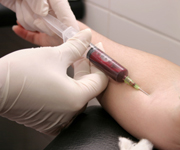AN Australian study that shows measuring glycated haemoglobin HbA1c level is a simple, inexpensive and effective screening test to detect undiagnosed diabetes will help shape new national guidelines on type 2 diabetes, experts say.
However, they warn that before screening for undiagnosed diabetes can be introduced to general practice, the issue of Medicare rebates would need to be resolved.
In the study, published in the latest MJA, serum HbA1c test was automatically done for all adult patients admitted to a tertiary hospital with a random plasma glucose level of 5.5 mmol/L or more.(1)
The authors said the prevalence of undiagnosed diabetes (defined as HbA1c 6.5% and over) among the study patients was 11%. This was three times higher than the community prevalence of undiagnosed diabetes. The number of patients with known diabetes was about 12%.
The HbA1c test cost was $152 per new diagnosis of diabetes.
A subset of 259 patients randomly selected for an oral glucose tolerance test (OGTT) after discharge proved less successful, with only 27% undertaking the test.
Associate Professor Michael d’Emden, director of endocrinology and diabetes at the Royal Brisbane and Women’s Hospital and chair of the newly formed committee on HbA1c for the Australian Diabetes Society (ADS), said the MJA study showed that measuring HbA1c level was an effective strategy for detecting undiagnosed diabetes.
“That’s why I think [there could be] a strategy that alerts GPs, or automates a process, whereby, if a fasting blood glucose level is between 5.5 mmol/L and 7 mmol/L, then you should do an HbA1c test,” he said.
“That would be pretty palatable for [Medicare Australia], I think, because getting a glucose test is part of a normal electrolyte profile so it involves no added cost and you are limiting further testing to a biochemical at-risk group.”
Professor Paul Glasziou, director of the Centre for Research in Evidence-Based Practice at Bond University, Queensland, and Professor Tim Davis, diabetologist at Fremantle Hospital in Western Australia, agreed that measuring HbA1c level was the best way to test.
Professor Glasziou said the downside to screening, such as false positives, overdiagnosis and labelling patients with a disease, had to be taken into account.
The current guidelines for detecting undiagnosed type 2 diabetes involve assessing risk factors, measuring fasting plasma glucose and performing an OGTT in people with fasting plasma glucose of 5.5‒6.9 mmol/L.
However, Professor d’Emden said people were reluctant to do an OGTT because it was time consuming, uncomfortable and had to be done fasting. Using HbA1c screening would deliver cost savings through fewer OGTTs and a substantial increase in the number of people having an appropriate diagnostic test, he said.
The general consensus of the ADS HbA1c committee was consistent with the World Health Organization recommendation that an HbA1c of at least 6.5% on two repeated tests is sufficient to diagnose diabetes.
Professor d’Emden said the ADS would hold discussions with the Royal College of Pathologists of Australasia to ensure the validity of, and confidence in, the test.
Professor Stephen Colagiuri, professor of metabolic health at the University of Sydney and a member of the HbA1c committee, said getting Medicare reimbursement for the new test was likely to be a slow process.
Medicare currently reimburses HbA1c only for monitoring of diabetes control in people with known diabetes.
Professor Colagiuri said using the screening method outside a hospital setting would be more costly, as doctor visits and other costs would need to be factored in, but it could be done in any situation where a blood sample was being collected, including general practice.
Coauthor of the study, endocrinologist Dr Matthew Doogue of Flinders University in Adelaide, said the main advantage of HbA1c testing was that fasting or glucose challenge testing was not required but it was not perfect because some people had misleadingly low results (false negatives).
It also relied on patients having blood tests for other reasons.
– Cathy Saunders
Posted 21 February 2011

 more_vert
more_vert
Sadly, the pre-test probability for undiagnosed diabetes in the Australian population is fairly high and thus false positives with elevated HbA1c is likely to be less of an issue than for rare disorders. Certainly, a ‘+ve’ HbA1c result should be confirmed with further testing. Marked iron deficiency (even with Hb in the normal range) can elevate HbA1c several points.
It is important though to note that the risk of CVS disease morbidity and mortality starts to rise in a linear fashion when HbA1c goes above 5% (well less than a ‘diabetes’ diagnostic level) reflecting the reality that full-on diabetes is a late stage in a spectrum of pathology starting with insulin resistance and hyperinsulinaemia with associated greater risk of hypertension, dyslipidaemia, hyperuricaemia, NAFLD, etc, long before glucose intolerance, impaired fasting glucose, metabolic syndrome or full diabetes develop.
The higher the HbA1c, the greater the likelihood of these pre-diabetes changes which should prompt us to look further for pathology and initiate lifestyle and other interventions earlier and hopefully prevent diabetes occuring at all!
That is the problem with any screening test – if applied to a population with low pre-test probability, there will be a large number of false-positives.
One has to be cautious with the interpretation of the HbA1c in isolation, if the rest of the patient’s medical status is unknown. For example, abnormal renal function may result in a falsely low result,
http://clinical.diabetesjournals.org/content/22/3/141.full
and anaemia may result in false elevation and a fallacious diagnosis of diabetes.
http://www.servier.com/App_Download/JFax/Diabetes/Gui17gb2.pdf
These are important caveats, and should be mentioned in any discussion of the HBA1c.